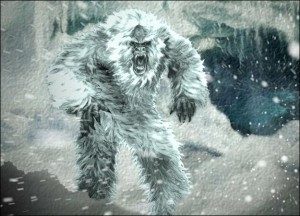 In the span of the last year there have been many ups and downs in the field of Bigfoot research. New films, videos and pictures have been presented, new foot impressions and even some hand impressions have been cast, some showing more promise than others of course. Some new hoaxes have been revealed and some older hoaxes have finally been exposed.
In the span of the last year there have been many ups and downs in the field of Bigfoot research. New films, videos and pictures have been presented, new foot impressions and even some hand impressions have been cast, some showing more promise than others of course. Some new hoaxes have been revealed and some older hoaxes have finally been exposed.
And finally, DNA sequencing has made its mark on the Sasquatch question, though unfortunately that mark was more like graffiti than anything else – I’m referring to Ketchum, of course. As of Thursday, October 17th though, the potential for genomic science to blast open the gates on the enigmatic Bigfoot has again been highlighted, though while many are claiming that the mystery is solved, some of us, myself included, are less sure.
In a series of press appearances, Professor of Human Genetics at The University of Oxford and Fellow of Wolfson College (UK), Dr. Bryan Sykes has begun talking about what some are calling ‘ground breaking conclusions’ in his unpublished paper on the genetic analysis of two separate samples of what are reported to be Yeti hairs.

Now that’s kind of a mouthful, and there is much to talk about. The news about his discovery is being talked about in the usual places; Bigfoot forums and Facebook pages, Twitter, various paranormal websites, as well as several news outlets, including Huffington Post and MSNBC. Sykes study apparently reveals that the infamous Yeti is in fact a previously believed to be extinct Snow Bear indigenous to the Himalayas.
About a year ago, Professor Sykes put out a call across the Bigfoot/Yeti research community, asking for skin, hair and other biological samples to be submitted for genetic evaluation. His call was answered and among the samples he received, were hairs thought to belong to the elusive Yeti found in and around the Himalayan Mountain Range. The first was a 40 year old sample submitted by a French mountaineer. This hair sample was allegedly taken from the corpse of a Yeti in the Western Himalayas near the Indian region of Ladakh. The other relevant sample was a hair found a decade ago, near Bhutan, some 800 miles to the east.
 Both hair samples, when sequenced and compared to a database of animal genomes, proved to be a match to a creature long thought extinct. The samples, which are only identified as belonging to a Yeti by the people local to their discoveries, shared a genetic fingerprint with a 40,000 year old polar bear jaw bone found in the Norwegian Arctic.
Both hair samples, when sequenced and compared to a database of animal genomes, proved to be a match to a creature long thought extinct. The samples, which are only identified as belonging to a Yeti by the people local to their discoveries, shared a genetic fingerprint with a 40,000 year old polar bear jaw bone found in the Norwegian Arctic.
Questions about whether the match between these samples and the polar bear suggest that the original species has survived in the mountains or if this represents a hybrid species of bear distantly related to the original species and currently known bear species, provides much to think about. And the fact that the samples were found so far apart is suggestive of there being a breeding population of these animals across a large range, rather than there being a few examples of a small population now extinct.
It seems that Sykes revelations are difficult to refute, and I admit that the science is probably solid. There is no logical objection to the assertion that these particular hair samples are that of an unknown or forgotten species of bear. What I question however, is whether those samples are indicative of an answer to the overall Yeti issue.

All are speaking as though Sykes study is the be-all-and-end-all of Yeti DNA research, but the truth is, the paper has yet to be published. In this regard the situation very much mirrors the Ketchum debacle, but there are some key differences. Sykes investigation is set to be discussed in a three-part TV documentary titled Bigfoot Files, beginning this Sunday, but the necessary peer-review has not taken place.
I’m not necessarily calling his conclusions suspect, as I neither possess the expertise to do so, nor are they particularly surprising (in contrast to Ketchum’s). Whether those samples do actually conform to the genetic profile of this particular polar bear species is almost beside the point, but we should be consistent in our criticism of the advancement of fact based not on peer-review but on sensationalist news coverage.
In reality, this study sheds little light on the Bigfoot/Sasquatch/Yeti phenomenon, and while Sykes warns that his conclusions are likely to be felt as a blow to the egos of the Bigfoot community, I’d take this opportunity to point out that his conclusions relate only to those samples investigated. We are, as was he, forced to accept that the samples he received were in fact those of two separate Yetis, for which there is no evidence beyond anecdotal and faded testimony. Without having had an opportunity to examine his paper, one cannot conclude that he has in fact been working with Yeti DNA. And I’m not entirely certain the details of his paper can adequately answer that question either.
It’s interesting, for sure, that he’s found a genetic link between these samples and the polar bear, and one can easily see how such an animal could be confused for a bipedal anthropoid, especially given the environmental conditions associated to many Yeti sightings. Polar bears are known to stand and walk upright on occasion, their fur is, ostensibly, similar in colour and texture to that reported in Yetis and their vocalizations could be said to be similar as well. But this is all speculative supposition that is, quite honestly, unrelated to Sykes investigation.
Sykes’ insight and commentary are welcomed into the community of Bigfooters and I look forward to getting a closer look at his work, both in his paper – which has been submitted for publication, though where I do not know – and in his coming book The Yeti Enigma: A DNA Detective Story, which is set to be released next spring. Though I remain cautious about embracing the furor this story seems to be generating.
